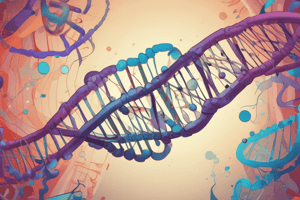Podcast
Questions and Answers
According to the Central Dogma, what serves as a template for translating genetic information into proteins?
According to the Central Dogma, what serves as a template for translating genetic information into proteins?
- Cell membranes
- Chromosomes
- Proteins
- RNA (correct)
What is the role of the process of segregation in determining genetic information in offspring?
What is the role of the process of segregation in determining genetic information in offspring?
- Determining the gender of the offspring
- Preventing genetic mutations in the offspring
- Ensuring that offspring receive a unique combination of genetic information (correct)
- Controlling the physical appearance of the offspring
How do differences in DNA sequences contribute to variations in organisms?
How do differences in DNA sequences contribute to variations in organisms?
- By leading to variations in proteins and resulting traits (correct)
- By having no effect on an organism's fitness
- By causing harmful mutations only
- By increasing the lifespan of an organism
What is the primary application of DNA testing in forensics?
What is the primary application of DNA testing in forensics?
How can DNA testing benefit agriculture?
How can DNA testing benefit agriculture?
Why is understanding heredity through the lens of DNA considered a foundational component of biology?
Why is understanding heredity through the lens of DNA considered a foundational component of biology?
What are the four nitrogenous bases found in DNA?
What are the four nitrogenous bases found in DNA?
What is the pairing rule for nitrogenous bases in DNA?
What is the pairing rule for nitrogenous bases in DNA?
What is the role of DNA in inheritance?
What is the role of DNA in inheritance?
How many base pairs approximately make up the human genome?
How many base pairs approximately make up the human genome?
What are chromosomes made of?
What are chromosomes made of?
During which process do homologous chromosomes pair up and separate into new cells?
During which process do homologous chromosomes pair up and separate into new cells?
Flashcards are hidden until you start studying
Study Notes
Heredity: Understanding Genetic Information through DNA
Heredity, the passing of traits from one generation to the next, is a fundamental principle of life that underpins our existence. At the heart of this fascinating and complex process lies DNA, or deoxyribonucleic acid, a double-helix structure that carries our genetic code.
DNA Structure and Organization
DNA is composed of nucleotides, which in turn are made up of a sugar molecule, a phosphate group, and one of four nitrogenous bases: adenine (A), cytosine (C), guanine (G), and thymine (T). The bases pair with each other in specific ways: A pairs with T, and C pairs with G. This paired structure forms the DNA double helix, with base pairs connected by hydrogen bonds.
The human genome, which holds the DNA of an individual, consists of approximately 3.2 billion base pairs organized into 23 pairs of chromosomes. Chromosomes are thread-like structures made of DNA that are found within the nucleus of human cells.
DNA's Role in Inheritance
DNA serves as the blueprint for the development and function of every organism. When an organism reproduces, its genetic information is passed on to its offspring through DNA replication and segregation during meiosis. Meiosis is a special type of cell division that produces germ cells, the cells that eventually develop into eggs and sperm.
During meiosis, homologous chromosomes, which are the two versions of the same chromosome, pair up and then separate into new cells. The process of segregation determines which version of a chromosome is inherited by the resulting gametes, or sex cells. This separation ensures that offspring receive a unique combination of genetic information, and their own genetic makeup is distinct from that of their parents.
DNA and the Central Dogma
The Central Dogma, a fundamental concept in molecular biology, describes the flow of genetic information from DNA to RNA to proteins. DNA is transcribed into RNA, which then serves as a template for translation into proteins through the process of protein synthesis. These proteins are the building blocks of life, and they serve various functions within cells and organisms.
Differences in DNA sequences can lead to variations in proteins and, ultimately, the traits that an organism exhibits. These variations, or genetic mutations, can be beneficial, harmful, or have no effect on an organism's fitness. Understanding these variations and their impacts is a central focus of genetic research.
DNA Testing and Applications
Advances in molecular biology and genetics have led to the development of various DNA-based tests, which are widely used in human health, forensics, and agriculture. These tests can reveal information about an individual's health, ancestry, or relationship to others.
For instance, DNA testing can be used to diagnose and screen for inherited diseases, such as sickle cell anemia and cystic fibrosis. DNA fingerprinting, a technique that identifies an individual based on unique DNA variations, is widely used in forensics to solve crimes and identify missing persons.
In agriculture, DNA testing can help breeders to quickly identify and select for desirable traits in plants and animals. By understanding the genetic basis of specific traits, breeders can develop new varieties with enhanced yield, disease resistance, and improved nutritional value.
Conclusion
Understanding heredity through the lens of DNA provides a fascinating glimpse into the complex processes that underpin life and evolution. From an appreciation of DNA's structure and role in inheritance, to the applications of DNA testing, the study of heredity is a foundational component of biology. As our understanding of DNA and its applications continues to grow, we can expect to see new opportunities and breakthroughs in the fields of medicine, genetics, and agriculture.
Studying That Suits You
Use AI to generate personalized quizzes and flashcards to suit your learning preferences.




